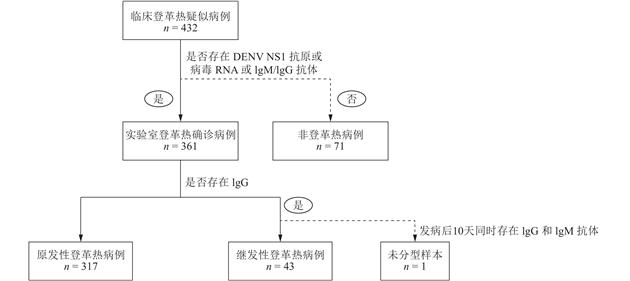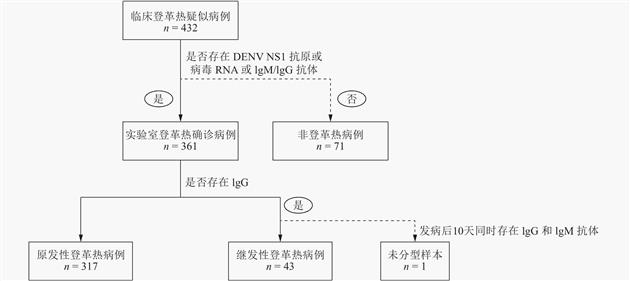| 登革热诊疗指南(2014年版) |
| |
| 引用本文: | 梁丹, 苏娟, 肖红, 黎薇, 柯碧霞, 柯昌文. 2014年广东省登革热流行期间实验室诊断评价[J]. 中国公共卫生, 2021, 37(3): 530-536. DOI: 10.11847/zgggws1127062 |
| |
| 作者姓名: | 梁丹 苏娟 肖红 黎薇 柯碧霞 柯昌文 |
| |
| 作者单位: | 1.汕头大学医学院,广东 汕头 515041;2.广东省疾病预防控制中心;3.南方医科大学 |
| |
| 基金项目: | 国家科技重大专项项目(2018ZX10714002003006);广东省省级科技计划项目(2019B030316013) |
| |
| 摘 要: | 
目的 本研究旨在评估登革热NS1抗原、病毒RNA和IgM抗体检测在登革热病毒感染早期实验室诊断中的应用。 方法 2014年6 — 11月,连续采集广东省疑似登革热患者432份血清样本,所有样本同时进行了4项商用诊断试验,包括NS1 快速诊断试验(RDT)、NS1 酶联免疫吸附试验(ELISA)、实时定量RT-PCR(qRT-PCR)试验和IgM/IgG ELISA试验。 结果 361例(83.6 %)样本被检出登革病毒NS1抗原或病毒RNA或IgM抗体阳性,其中317例(87.8 %)和43例(11.9 %)为原发性和继发性登革热病例。NS1抗原总阳性率最高(358份,82.9 %),其次是病毒RNA(268份,74.3 %)和IgM抗体(179份,49.5 %)。在采集标本时,本研究观察到疾病早期NS1抗原和病毒RNA呈阳性、而IgM抗体是逐渐出现阳性的时间变化。
NS1 RDT(97.0 %)和NS1 ELISA试验(98.6 %)对急性期和急性后期标本的敏感性均显著高于qRT-PCR(88.9 %)和IgM-ELISA(59.3 %)试验(P < 0.01)。NS1 RDT和NS1 ELISA的检测结果相似,具有较好的一致性(κ = 0.363,P < 0.001),qRT-PCR对急性期标本的敏感性高于IgM-ELISA(P < 0.01)。 结论 在以原发性感染为主的非登革热疫区国家,应重视高灵敏度的NS1抗原检测。病毒RNA检测对登革热早期诊断仍有价值,而IgM抗体检测最适合作为第5天或第5天以上患者的辅助诊断方法。为了从诊断角度及时做出适当的疫情反应,迫切需要这些信息和进一步的调查。

|
| 关 键 词: | 登革热诊断 NS1抗原检测 ELISA 侧流免疫层析 RNA qRT-PCR 抗登革热IgM抗体 |
| 收稿时间: | 2019-11-19 |
|
| 点击此处可从《中国公共卫生》浏览原始摘要信息 |
|
点击此处可从《中国公共卫生》下载全文 |
|



